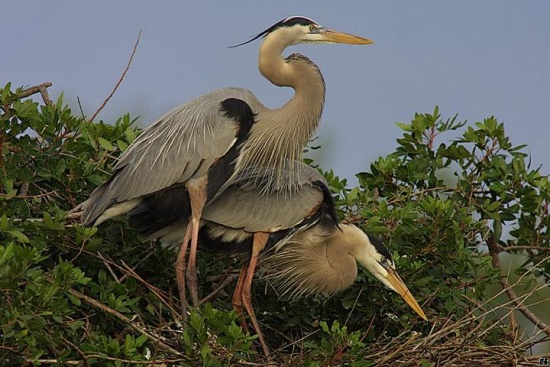BigRedBirder (talk | contribs) m (→Identification) |
BigRedBirder (talk | contribs) |
||
| Line 12: | Line 12: | ||
===="Great White" Heron==== | ===="Great White" Heron==== | ||
There is also an all white version of the Great Blue Heron, the "Great White" Heron, that can be found in southern [[Florida]]. It has yellow legs, a yellow bill and white feathers. | There is also an all white version of the Great Blue Heron, the "Great White" Heron, that can be found in southern [[Florida]]. It has yellow legs, a yellow bill and white feathers. | ||
| + | |||
| + | Similar to [[Great Egret]]. | ||
==Distribution== | ==Distribution== | ||
Revision as of 22:52, 1 January 2008
- Ardea herodias
Identification
The largest heron in North America, three to four feet tall
W. 6ft
- Blue-gray feathers on most of its body
- Plume of feathers on its chest and back during breeding
- Long, pointed yellow bill
- Long legs
- Adults have white on the top of their heads and long black plumes above their eyes.
"Great White" Heron
There is also an all white version of the Great Blue Heron, the "Great White" Heron, that can be found in southern Florida. It has yellow legs, a yellow bill and white feathers.
Similar to Great Egret.
Distribution
It is found throughout most of North America, including Alaska, Quebec and Nova Scotia. The range extends south through Florida, Mexico and the Caribbean to South America. Very rare vagrant to the Azores and U.K.
Taxonomy
Kingdom: Animalia Phylum: Chordata Class: Aves Order: Ciconiiformes Family: Ardeidae Genus: Ardea Species: A. herodias
Habitat
Margins of lakes and slow-flowing rivers, swamps and marshes, frequently on sea-coasts, in estuaries and mangroves.
Behaviour
The great blue heron migrates in the fall, although some stay in the northern part of their range. The great blue heron usually tucks its head into an S-shape when it is resting and flying.




